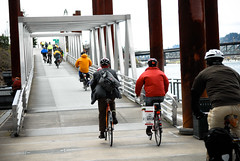As part of their ongoing effort to identify and fund non-motorized transportation projects, Metro plans to submit a grant application for federal stimulus funding to the tune of $75 to $100 million.
In an email about the news to Metro’s Executive Council for Active Transportation, project manager Lake McTighe wrote that the application will, “detail a strategy to get much more aggressive about tapping transportation funding for trails and on-street bicycle and pedestrian facilities.”
The Executive Council for Active Transportation is a newly formed, 15-member group (chaired by Jonathan Nicholas) that is an outgrowth of Metro’s Blue Ribbon Committee for Trails. Their mission is to promote a regional transportation strategy that promotes more biking and walking.
(The Blue Ribbon Committee for Trails published a 17-page paper titled, “The case for an active transportation strategy” in November 2008 which you can download here (1.5MB PDF)).
“Whether this application is successful or not, it shows the active transportation strategy is working and our efforts are starting to pay off.”
— Lake McTighe, Metro
Metro will ask the federal government to fund their concept of making the Portland metro region a national petri dish of how substantial investments in biking and walking infrastructure can produce major deductions in vehicle miles traveled (VMT), a healthier population, better access to natural areas, and so on. In the email, McTighe noted that their investment strategy for active transportation projects should resemble how TriMet has approached their investments for light rail expansion.
Metro will submit the grant through the Transportation Investments Generating Economic Recovery (TIGER) program, which was signed into law as part of President Obama’s Recovery Act. There are $1.5 billion dollars available through the TIGER program for, “capital investments in surface transportation infrastructure projects that will have a significant impact on the Nation, a metropolitan area, or a region.”
The fact that Metro is even in a position to get an application together for TIGER speaks to the great success they’ve had in organizing around the active transportation principle. Their Active Transportation Partnership is already in the process of receiving project proposals (deadline for final proposals is August 14th). McTighe says that they’ll pull three projects — one urban, one suburban and one “urban to nature” — from those submissions to include in their TIGER proposal.
For some perspective, two major trail projects that are sure to be submitted to Metro for consideration are the North Portland Greenway and the Sullivan’s Gulch trails. Both of those could be built for about $70 million total.
McTighe also points out that this is the only proposal that the Metro Council is advancing for the TIGER Grant. “Whether this application is successful or not,” she wrote, “it shows the active transportation strategy is working and our efforts are starting to pay off.”
According to the U.S. Department of Transportation web site, TIGER Grants will be announced by February 17, 2010.
Learn more about Metro’s Active Transportation Partnership here.


